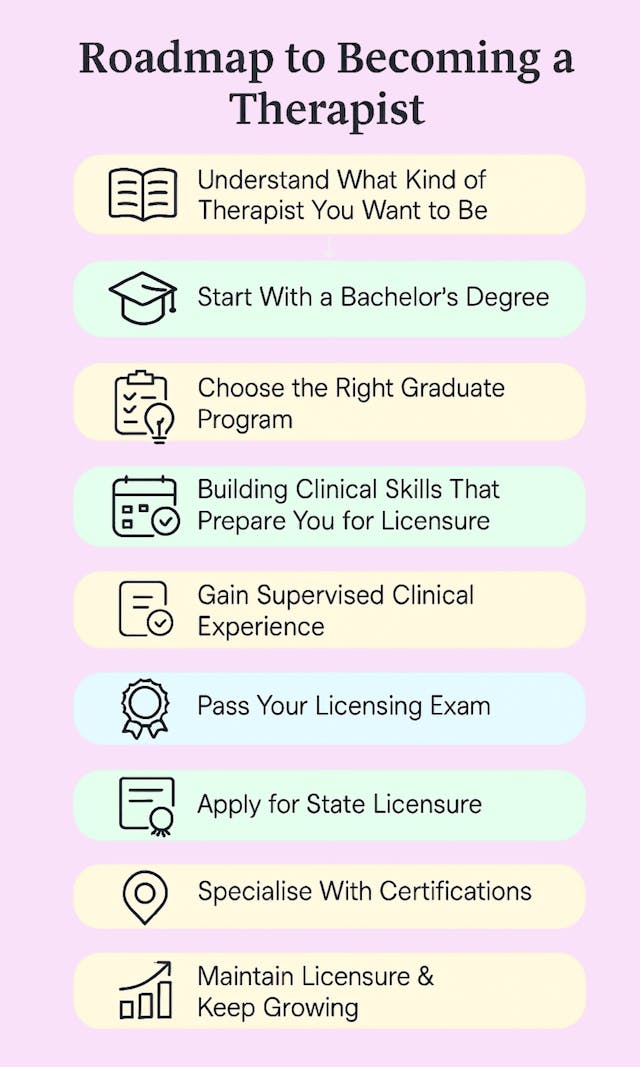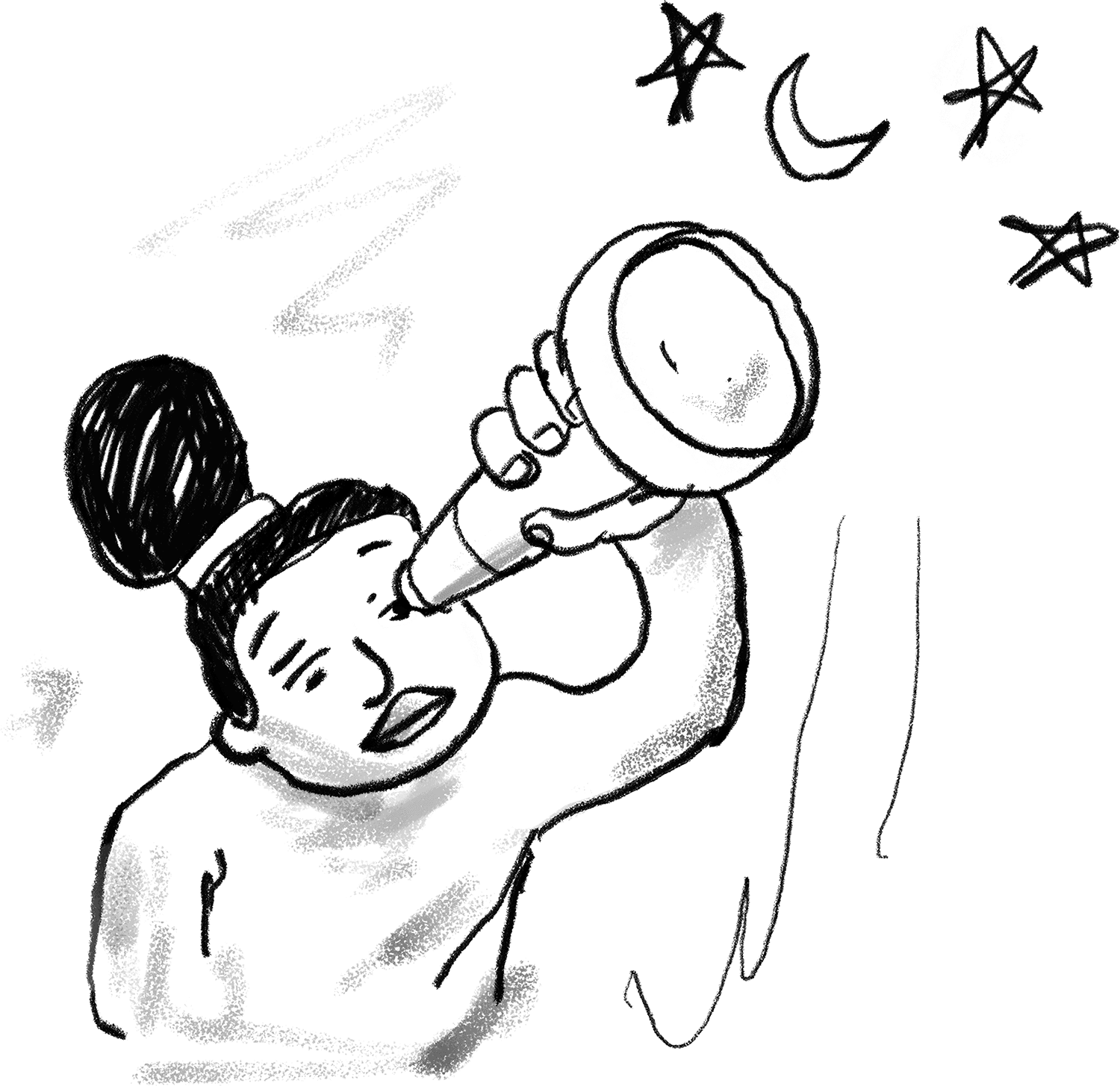You’re drawn to helping others, whether through listening deeply, supporting friends in crisis, or imagining a future where healing is your full-time work.
Becoming a therapist offers a meaningful, purpose-filled career. But getting there takes more than compassion, it takes clarity, commitment, and clinical readiness.
In this blog, we’ll walk you through how to become a therapist, from a bachelor’s degree to licensure, supervision, to specialisation. Whether you’re just starting or exploring a mid-career change, this guide offers a real-world roadmap to becoming a licensed mental health professional.
Roadmap to Becoming a Therapist
This image gives a visual overview of the core steps.

Let’s break them down in more detail below.
Detailed Breakdown: How to Become a Therapist
1. Understand What Kind of Therapist You Want to Be
Before jumping into grad school applications, reflect on the type of therapy work that truly excites you.
Your choice will shape the kind of degree you pursue, the clients you serve, and even the settings you’ll work in.
Here’s a deeper look at the most common therapist types and licenses:
Therapist Type | Degree Needed | Common License(s) | Where They Work |
|---|---|---|---|
Licensed Professional Counselor (LPC) | MA/MS in Clinical Mental Health Counseling | LPC, LMHC, LPCC | Private practice, clinics, community mental health |
Licensed Clinical Social Worker (LCSW) | MSW (Social Work) | LCSW, LICSW | Hospitals, government agencies, nonprofits |
Marriage & Family Therapist (MFT) | MA in Marriage & Family Therapy | LMFT | Couples therapy, family counseling, private practice |
Licensed Psychologist | PhD or PsyD in Psychology | Licensed Psychologist | Hospitals, research, assessments, higher education |
Addiction Counselor | Varies (bachelor’s or master’s level) | CADC, LAC, MAC | Rehab centers, clinics, correctional facilities |
School Counselor | MA/MS in School Counseling | Varies by state (e.g., PPS credential in CA) | K–12 schools, academic support, student wellness |
Not all licenses are equal across all states. Some titles (like LMHC vs. LPC) are interchangeable, while others (like psychologist) require specific degrees and longer training.
If you’re unsure, consider job shadowing, volunteering, or setting up informational interviews to explore which path fits you best.
2. Start With a Bachelor’s Degree
You don’t need to major in psychology- but it helps.
A bachelor’s degree in psychology, social work, human behavior, sociology, or education provides a strong foundation in the educational requirements for therapy careers.
Make the most of this stage:
- Keep your GPA above 3.0 for grad school competitiveness
- Volunteer in crisis centers or community mental health clinics to gain experience
- Ask for letters of recommendation from professors
- Participate in undergraduate research if aiming for a doctoral degree
This phase introduces you to developmental psychology, counseling basics, and the higher education needed to become a therapist.
3. Choose the Right Graduate Program
To become a licensed therapist, you’ll need to pursue a graduate degree aligned with your chosen specialization. Your degree determines your license type, career path, and clinical setting.
Here are common therapist tracks:
Degree | Typical Licenses |
|---|---|
MA/MS in Clinical Mental Health Counseling | LPC, LMHC, LPCC |
MSW (Master of Social Work) | LCSW |
MA in Marriage & Family Therapy | LMFT |
PhD or PsyD in Psychology | Licensed Psychologist |
Make sure your program is accredited by:
If you are considering online programs, then make sure to double-check with your state board to confirm they meet licensure requirements where you plan to practice.
4. Building Clinical Skills That Prepare You for Licensure
Once you’ve entered graduate school, your focus shifts from theory to application. This is where you start developing your identity as a therapist.
Most programs take 2–3 years and are divided into three core components:
1. Classroom Foundations
You’ll complete coursework that lays the groundwork for clinical work, including:
- Counseling theories and treatment planning
- Trauma-informed care and cultural competence
- Ethics, legal responsibilities, and professional boundaries
2. Practicum & Internship Experience
Your program will include hands-on training through:
- Practicum (~100 hours): Introductory experience working with clients
- Internship (600–1,000 hours): Supervised clinical work where you co-lead sessions, conduct assessments, and apply treatment models
This real-world training is often done in settings like clinics, schools, or hospitals—and helps you build confidence, competence, and clinical judgment.
3. Specializations and Modalities (Optional)
Some programs offer elective training in:
- Cognitive Behavioral Therapy (CBT)
- EMDR (for trauma)
- Play Therapy or Family Systems
- Addiction or crisis intervention
This focus area helps guide your future client base and work setting- and may align with continuing education or certification goals down the line.
5. Gain Supervised Clinical Experience
Graduate school gives you a taste of client work- but true growth happens through supervised clinical experience, which spans both your degree program and post-graduate training.
During Graduate School
- Practicum (~100 hours): Early exposure to therapy environments
- Internship (600–1,000 hours): Structured, supervised client work in real-world settings
These placements allow you to apply classroom concepts, receive feedback, and begin developing your clinical voice.
After Graduation
To qualify for licensure, you’ll need to complete additional postgraduate supervised hours, usually between 1,500 and 4,000, depending on your state and license type.
- All hours must be supervised by a licensed clinician in your field (LPC, LCSW, LMFT, etc.)
- You'll keep detailed logs of client hours, types of cases, and supervision sessions
- This stage often takes 1–2 years, and is a required step before sitting for your licensing exam
Overwhelmed by your first therapy note?
Supanote helps you write clean, clinical notes fast
tart your Free Supanote Trial Now!
6. Pass Your Licensing Exam
After completing your supervised hours, the next big hurdle is passing your licensing exam. This is your official gateway to independent practice.
Here are the most common exams by license type:
License Type | Exam |
|---|---|
LPC | National Counselor Exam (NCE) or NCMHCE |
LCSW | ASWB Clinical Exam |
LMFT | MFT National Exam |
Psychologist | EPPP (Examination for Professional Practice in Psychology) |
If you want to ace these exams, then plan to start studying 3–6 months in advance, using official guides, prep courses, and practice exams from trusted sources like NBCC, ACA, or ASWB.
7. Apply for State Licensure
With your degree, supervised hours, and exam results in hand, you're ready to apply for licensure through your state board.
Typical state requirements include:
- Verified graduate degree
- Documentation of clinical hours
- Exam scores and proof of passing
- Jurisprudence exams, background checks, or fingerprinting
- Application fees and paperwork
If you plan to move, check whether your state offers license portability, which can make transferring your credentials easier. Since licensing titles and requirements differ by state, always verify details with the relevant state board.
8. Specialise With Certifications
Once licensed, many therapists choose to deepen their expertise with specialty certifications that can enhance clinical outcomes and increase career opportunities.
Popular certifications include:
- CBT (Cognitive Behavioral Therapy)
- EMDR (Eye Movement Desensitization and Reprocessing)
- CCTP (Certified Clinical Trauma Professional)
- Play Therapy
- Addiction Counseling Credentials
These not only boost your credibility but often count toward continuing education (CE) requirements.
Specializing can also help you niche down in private practice, attract specific clients, or work in targeted care environments.
9. Decide Where to Practice
Therapists work in a wide range of settings and where you choose to practice shapes your daily routine, income potential, and overall job satisfaction.
Here’s a quick comparison of common work environments:
Setting | Pros | Cons |
|---|---|---|
Private Practice | Autonomy, flexible schedule | Requires business management and billing skills |
Hospitals/Clinics | Stability, benefits | More structured, less flexibility |
Community Mental Health | High need, diverse populations | Lower pay, higher burnout risk |
Schools | Daytime hours, prevention-focused | May require school counseling credentials |
When choosing your setting, consider your preferred pace, population, and how much structure or independence you thrive in.
10. Maintain Licensure & Keep Growing
Therapists are lifelong learners- and to maintain licensure, you'll need to complete continuing education (CE) every renewal cycle (typically 12–40 hours depending on your state).
Here’s how to keep evolving in your career:
- Join supervision or peer consultation groups
- Attend conferences and workshops for mental health professionals
- Explore advanced training in trauma, cultural humility, or evidence-based models
- Prioritize your own wellness to avoid burnout and stay effective as a clinician
How Much Do Therapists Make- and How Long Does It Take?
How Long Does It Take to Become a Therapist?
The journey from undergrad to licensed therapist usually takes 6 to 8 years, depending on your degree path, supervision timeline, and whether you study full- or part-time.
Here’s a typical breakdown:
Milestone | Estimated Time |
|---|---|
Bachelor’s Degree | 4 years |
Master’s Degree | 2–3 years |
Supervised Experience | 1–2 years (may overlap with work) |
Licensing Process | A few months |
If you’re pursuing a doctoral path (PhD or PsyD), plan for an additional 2–4 years, especially if you're entering research or psychological assessment.
If you’re going part-time, or working while studying, your timeline may be longer- but still completely achievable with the right planning.
Therapist Salary: What Can You Expect to Earn?
Therapist salaries vary depending on license type, work setting, geography, and experience level. Here’s a general overview of what you can expect in the U.S:
Therapist Type | Typical Salary Range |
|---|---|
LPC / LMHC / LPCC | $50,000 – $80,000 |
LCSW (Social Worker) | $55,000 – $90,000 |
LMFT | $50,000 – $85,000 |
Licensed Psychologist (PhD/PsyD) | $80,000 – $120,000+ |
Addiction Counselor | $45,000 – $70,000 |
Private Practice Owner | $100,000+ (varies by caseload) |
What affects your income?
- Location: Urban vs. rural, high-demand states
- Specialization: Trauma, EMDR, couples therapy, ADHD, etc.
- Setting: Private practice tends to pay more, but includes admin overhead
- Insurance vs. cash-pay: Insurance panel providers often have lower per-session fees but steadier volume
Pro tip: Many therapists increase their income by adding coaching, writing, speaking, supervision, or group programs once licensed.
Frequently Asked Questions
Q. Can I become a therapist without a psychology degree?
A. Yes. An undergraduate degree in education, sociology, or human services can still qualify you for graduate school.
Q. What is the typical path to becoming a therapist?
A. Bachelor's degree → Master’s degree → Supervised experience → Licensing exam → State licensure
Q. How long does it take to become a licensed therapist?
A. Typically 6–8 years total.
Q. Are there fast-track options?
A. Some graduate programs offer accelerated formats or advanced standing based on prior education.
Q. What do mental health counselors earn?
A. Entry-level salaries start around $45K. Private practice therapists may earn over $100K depending on location and specialization.
Q. Do therapy careers require medical school?
A. No. Only psychiatrists (who prescribe medication) attend medical school. Therapists do not.
Q. What are some common mistakes to avoid as a new therapist?
A. Taking on too many clients too fast, not seeking supervision, and neglecting self-care are a few early missteps to watch for.
Q. Do therapists need malpractice insurance?
A. Yes. Most clinical supervisors and employers require therapists to carry individual liability or malpractice insurance.
Q. Can I work internationally as a licensed therapist?
A. It depends on the country. Some nations recognize U.S. licenses or offer transfer pathways, while others require retraining or local certification.
Q. What should I look for in a clinical supervisor?
A. Look for someone who aligns with your values, provides consistent feedback, and has experience in your area of interest.
Q. How many clients does a full-time therapist typically see?
A. It varies, but full-time therapists often see between 20–30 clients per week, depending on setting and capacity
Q. Can I combine therapy with other careers or services?
A. Yes. Many therapists integrate coaching, writing, speaking, or consulting into their professional lives.
Q. How long does it take to become a therapist in NC?
A. In North Carolina, it typically takes 6–8 years: 4 years for a bachelor’s degree, 2–3 years for a master’s degree, plus supervised clinical hours and passing the licensing exam.
Q. What is required to be a therapist in California?
A. California requires a master’s degree in counselling or related field, completion of 3,000 supervised hours, passing the California Law and Ethics Exam and national exams (e.g., NCE or MFT), and applying through the Board of Behavioral Sciences (BBS).
Get Back to Clients, Not Paperwork
Supanote helps licensed therapists auto-generate therapy notes in seconds
Try Supanote for Free Today
